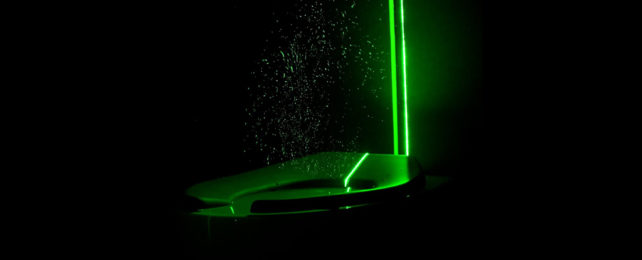Scientists used a combination of green lasers and cameras to shine a light on the effect a toilet flush has on its surroundings – and we doubt you'll chance leaving the lid up while flushing ever again after seeing the results.
The video clip produced by a team of researchers from the University of Colorado, Boulder, in the US shows a flurry of small water droplets, invisible to the naked eye, flying up from the toilet bowl after flushing. It's sort of super gross, if you think about what might be suspended in those tiny drops.
"People have known that toilets emit aerosols, but they haven't been able to see them," says civil and environmental engineer John Crimaldi, from the University of Colorado Boulder.
"We show that this thing is a much more energetic and rapidly spreading plume than even the people who knew about this understood."
As the researchers themselves admit, there's an "ick factor" here – enhanced by the eerie green glow of the laser light – but there's also an important message about bathroom hygiene, in both private homes and public restroom toilets that are often lid-less.
Crimaldi and his fellow researchers are keen to emphasize that they're not epidemiologists, and so there are no precise calculations here in terms of the potential for disease spread. However, their display provides a graphic element to other studies that do attempt to estimate qualities of bacterial-laden aerosols.
While previous studies have clearly established the potential for particles to escape the toilet bowl during flushing, there's still a lot of uncertainty about how these particles travel and where they might get to.
Two lasers were used: one continuously shining on the toilet from above illuminating the scene, and one sending out fast pulses of light across the top of the toilet bowl to highlight particle movement. High resolution images were captured with cameras at the same time.
The researchers showed droplets reaching a height of up to 1.5 meters (4.9 feet) after a flush, traveling at velocities that exceeded two meters (6.6 feet) per second in some places. Larger droplets settle on services more quickly, while smaller ones can hang around in the air for several minutes, the researchers showed.
"We had expected these aerosol particles would just sort of float up, but they came out like a rocket," says Crimaldi.
"The goal of the toilet is to effectively remove waste from the bowl, but it's also doing the opposite, which is spraying a lot of contents upwards."
There was nothing in the toilet bowl except water during the experiment. There was also no stall enclosing the toilet, nor were there people moving around as there might be in a public restroom. In real life, all of these variables would affect the travel of the droplets.
However, even in this rather artificial setting, there's clearly a lot of scope for water – and anything it happens to be carrying – to make it out of the toilet bowl, where it could end up stuck to surfaces and clothing.
The researchers think that more should be done to lower the risk of pathogens like Escherichia coli, Clostridium difficile, noroviruses, and adenoviruses spreading in public restrooms, with improved approaches to design, ventilation and disinfection all options.
For these improvements to work effectively, it's crucial to know where the water is traveling, which this study shows more dramatically than ever before – and in a way that we're never going to forget.
"If it's something you can't see, it's easy to pretend it doesn't exist," says Crimaldi. "But once you see these videos, you're never going to think about a toilet flush the same way again."
"By making dramatic visual images of this process, our study can play an important role in public health messaging."
The research has been published in Scientific Reports.
